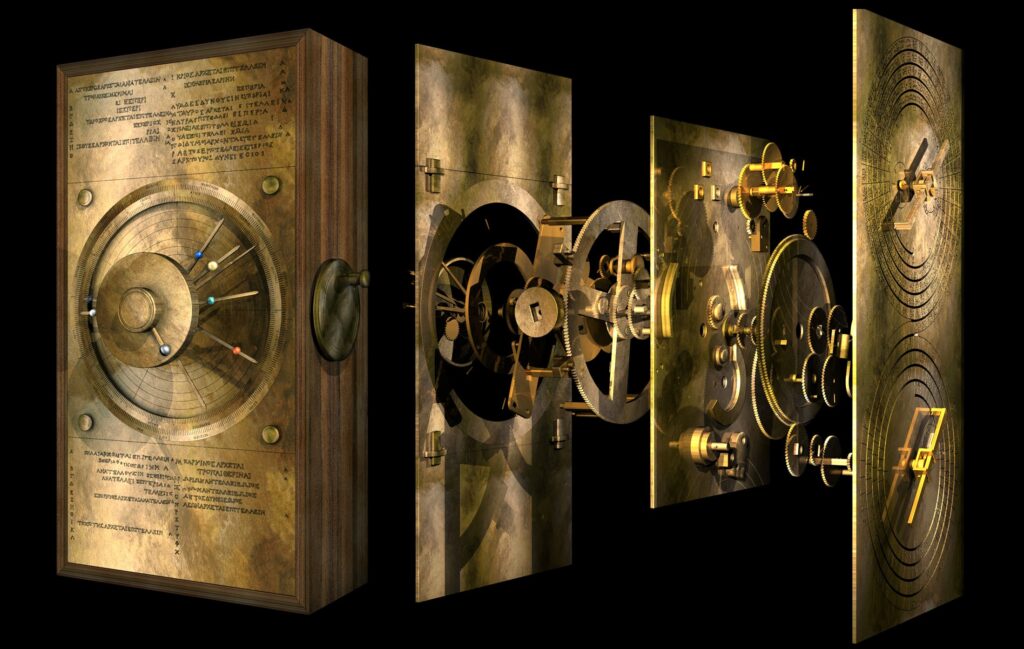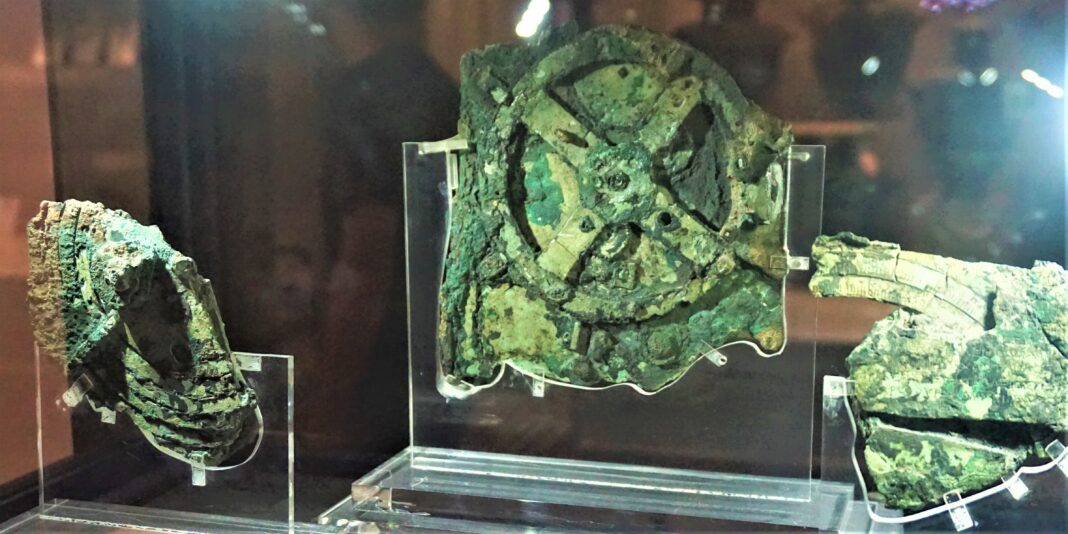Two thousand one hundred years ago, Antikythera Mechanism was an elaborate, spinning, wind-up device consisting of 34 bronze gears. It may have been housed in a wooden case about the size of a shoebox. Operated by a hand crank, it would have shown the time and movements of celestial objects with amazing accuracy. It had dials to count the days of probably three different calendars. Another dial may have been designed to calculate the timing of the Olympic games! Thin metal hands with the planets and stars could have rotated around its front, representing their location in connection to Earth. A small, metal globe signifying Moon would have rotated, showing black and white colours to imitate the waxing and waning of the Moon. It must have been the most sophisticated device in ancient Greece. Until the geared clocks were made in the 14th Century in Europe, no comparable mechanical device was found anywhere in the world. When it could have been made? Where it could have been made? Who could have designed and made such a complex device? How did the precision bronze gears were made? Why did the Greeks make a device that was compact, precise and portable? Were the Greeks really advanced in science, technology and innovation? Let’s dive into the past!
Where it was found?
In the first week of April 1900, from the Greek Island of Symi, Captain Dimitrios Kontos and his crew of sponge divers were sailing via the Aegean Sea to fish off the North African coast. Near Crete, they stopped at the island of Antikythera and waited for stronger winds. During this stopover, they dived into the sea wearing canvas suits and copper helmets. One of the divers, Elias Stadiatis had gone to 45 meters depth and suddenly signalled to be pulled up. Upon reaching the ship, he described that he saw a large sunken ship on the seafloor with a mound of human skeletons, horse carcasses, statues, wine jars and wooden boxes. Captain Kontos immediately wore the diving gear and jumped into the sea. About an hour later, he returned to the ship with an arm of a statue. Soon they left to fish for sponges as planned. While they were returning back, they stopped at the same place near Antikythera and recovered further artifacts from the shipwreck. Kontos reported the findings to the authorities and soon navy ships were sent to salvage the wreck. It took over two years and several attempts to recover as many artifacts as possible from the bottom of the ocean. There was a written reference that a ship went down between 76 and 66 BC and may have been on its way to Rome from Greece with many precious loots to be showcased in a Roman victory parade for Julius Caesar.
Who has found it?
By the summer of 1901, numerous artifacts were recovered from the shipwreck. There were bronze statues, bronze busts, marble sculptures, marble busts, marble horses, bronze lyres, pottery, glasswork and wooden boxes. But the salvation was stopped due to a diving accident in which diver Giorgos Kritikos perished and two others were paralysed probably due to decompression sickness. The artifacts were taken to the National Archaeological Museum in Athens. On 17 May 1902, Greek archaeologist Valerios Stais found the most extraordinary object while he was scrutinising the artifacts. He saw a severely corroded object that had a gear wheel entrenched with readable engravings in Greek. That object was named as the Antikythera Mechanism. It was initially thought to be a mechanised clock or an astrolabe. The shipwreck remained untouched until 1953, when French naval officer Jacques-Yves Cousteau surveyed the wreck. In the summer of 1976, at the invitation of the Greek government, Cousteau returned to the wreck with a team of divers and modern equipment. They recovered over 400 artifacts including hull planks, wine jars, gold, silver and bronze coins, marble statues, bronze busts and even human remains. Of all the artifacts recovered, the Antikythera Mechanism stood out. It was anything the archaeologists have ever seen from a shipwreck.
What actually is it?
The Antikythera Mechanism is similar to an old mechanical wall clock. The bits of wood found on it suggests that it was enclosed in a wooden case. Similar to an old clock, the case may have had a large circular face with rotating hands. There could have been a handle or knobs on the side for winding the mechanism either forward or backward. As the handle is rotated, the trains of gearwheels turned at least seven hands at varying speeds. Instead of hours and minutes, the metal hands displayed the position of the Sun and Moon, the phases of the Moon and probably the positions of the planets for any given day. There were 7 hands, one each for the Sun, Moon, Mercury, Venus, Mars, Jupiter and Saturn. A metal ball painted half in black and the other half in white displayed the phases of the Moon. The engravings described which stars rose and set on a specific date. There were two separate dials on the back of the case, each with a metal pointer that trailed its dedicated spiral groove like the needle of a gramophone player. One of these dials was a Greek calendar. The other exhibited the timings of solar and lunar eclipses. The Antikythera Mechanism must have been far ahead of its time by at least 1600 years. Inventions such as the Antikythera Mechanism can’t come out of nowhere. It could have taken hundreds of years to perfect the mathematical and mechanical calculations to manufacturing it as even a miscalculation could render it unusable.
How old is it?
There wasn’t radiocarbon dating technology in use until 1960. Dating the artifacts from the shipwreck was difficult, took several years and is still work in progress. But history has clues and points to connect. Some renowned Greek archaeologists and historians think that the ship was loaded with the loots of the Roman General Sulla from Athens in 86 BC and may have been on its route to Rome. There is a reference by the Greek writer Lucian that one of Sulla’s ships sunk near the region of Antikythera. Supporting the assumption that the ship should have sunk in the First century BC, there were household utensils and objects similar to those from the First century BC. The amphorae jars salvaged from the wreck dated to 85-65 BC, ceramics were dated to 75-55 BC and pottery was dated to 80-60 BC. Most of the coins recovered by Jacques-Yves Cousteau in 1976 were minted in 75-65 BC. The bronze statues were dated to the fourth century BC. The marble statues were presumed to be a replica of previous works. The hull planks of the ship were made with elm wood, which was widely used by the Romans to build their ships. Finally, in 1964, a piece of the hull plank was carbon dated to 220 BC ± 50 years. The difference in the radiocarbon date and anticipated date was assumed that the hull plank must have been from an elm tree which was cut several years ago than the date of sinking. In 1959, Professor Derek J. de Solla Price of Yale University had published his understandings of the Antikythera Mechanism. He detailed that it was a mechanical calendar and was made in 87 BC based on its engravings.
When was it made?
The Antikythera Mechanism is the most technically advanced mechanical device of its time. It could be older than we think and maybe not entirely made in ancient Greece. With the advancements in radiocarbon dating and imaging technologies, it has now become possible to image the internal parts of the mechanism without touching it as it is very fragile. After analysing the images, the researchers think they have identified a solar eclipse forecasted by the mechanism. They have also compared the prediction with the Saros cycle of eclipses used by the Babylonians 2,500 years ago. They have concluded that starting date of the mechanism should have been 12 May 205 BC – about 104 years earlier than originally thought. Since the mechanism gets its astronomical calculations right, the accuracy of the device must have been the major priority of the person who made it. It indirectly assisted to guess when it could have been made. The dial on the lower back of the device is similar to the Saros cycle of eclipses used by the Babylonians. The mechanism was developed according to the mathematical principles of the Babylonians rather than the trigonometry principles of the Greeks as it wasn’t developed in 205 BC.
Where was it made?
While the mathematical principles used was of Babylonian origin, the mechanical principles used to make the mechanism is of Greek origin. The engravings on the dial are Greek. The dial forecasts when the Olympic games will be held. There is an engraving stating an athletic event on the Island of Rhodes. The markings on the face of the mechanism are the Babylonian and Egyptian dates, translated into Old Greek. Alexander Jones, a professional in the history of ancient mathematical sciences at New York University thinks that the Antikythera Mechanism should have been made in the Island of Rhodes. The ancient Greek scientists Hipparchus, Posidonius and Archimedes have visited or subsisted in the Island of Rhodes. The location of the Island of Rhodes is closer to Turkey. Istanbul, the capital of Turkey was called Constantinople in the ancient. Constantinople was the most significant place in the ancient world. People, products and ideas from all over the world had passed through Constantinople into modern day Europe. Probably, the Greeks got the mathematical principles of Babylon in Constantinople. According to several ancient historical records and writings, Constantinople was an ancient Greek city. Modern Istanbul is still referred as Constantinople in the Greek-speaking world!
Who could have made it?
It is challenging to judge who could have made the Antikythera Mechanism. It is impossible to pick an individual. Once again, history gives us clues! The calendar on the back of the mechanism has the month names used in the Corinth province and its colonies in North-West Greece. A dial that predicted the timings of athletic festivals such as Olympics, lists Naa, a festival held in North-West Greece and Halieia, held in the Island of Rhodes. The ancient Greek philosopher and scientist Posidonius had a workshop on the Island of Rhodes. According to the account of the famous Roman statesman, Marcus Tullius Cicero, Posidonius made a device that displayed the position of the celestial objects in the early First century BC. Cicero also mentioned that a device made in bronze was built by Archimedes in the Third century BC. Probably, it could be Hipparchus, a Greek astronomer and mathematician who lived in the Island of Rhodes in the Second century BC. He may have worked out the mathematical and mechanical calculations used to make the mechanism. He was known for blending the arithmetic-based calculations of Babylonians with the geometric-based calculations of the Greeks. Regardless of who originally made it, the individual would have been a prodigy in his lifetime.
What was it made of?
The Antikythera Mechanism was made with bronze and housed in a wooden case. Bronze is not a metal. It is an alloy, made with copper, tin and adding metals such as aluminium, nickel, manganese or zinc and the non-metals (metalloids) such as phosphorus or silicon. Bronze has higher malleability than copper, hence it was of significant interest in making several tools in the prehistoric world. Bronze was first made earlier than 3000 BC, but its use in making artefacts and tools didn’t happen until 300 BC. Making bronze is a highly-skilled effort. It needs in-depth knowledge about metals and non-metals and training in metal smelting, smithing and forging. Making a device like the Antikythera Mechanism necessitates much more than knowledge and skills. It should have required extensive knowledge of the astronomy, mathematics and mechanical engineering. Achieving the level of ingenuity and proficiency would have taken several decades. The bronze used to produce the Antikythera Mechanism is of high quality. The analysis of its bronze showed that it was made with 84% copper, 12% tin, 1% aluminium, 1% nickel, 1% zinc, 1% silicon and traces of manganese. Due to the exceptional quality of bronze, the Antikythera Mechanism survived for over 2000 years in the deep sea.
Why was it made?
When it was finally identified in 1902, the archaeologists at first thought that the Antikythera Mechanism was either a clock or calculating device. For decades, it was uncertain whether it was an early astrolabe or an astronomical toy model. In 1959, Professor Derek J. de Solla Price gave a detailed mechanical breakdown of the mechanism. He described that the mechanism was used to calculate the exact location of the Sun, Moon, Planets and Stars in the sky on a specific day. A larger gear would rotate to illustrate the calendar year, and in turn rotate several separate small gears to depict the motions of the Sun, Moon and Planets. The Aegean Sea is home to about 1,000 larger and smaller islands. The ancient Greeks had settled on several of the islands such as Crete, Rhodes, Cos, Chios, Delos and Kythera. The ancient maritime trade passed through several of these islands. Hence, it must have been important to predict the position of the Sun, Moon and Planets as they critically influenced the weather patterns, directions of the wind and even surface currents of ocean. The ancient Greeks used ships for travelling and transporting goods between the islands. Also, used ships to control their colonies far and wide. The Antikythera Mechanism must have been invented out of that great necessity.
What is the mystery?
The Antikythera Mechanism had 34 bronze gears of variable sizes. Each gear was custom-made and served different functions. A pivotal shaft rotated the gears for measuring the movements of the Sun, Moon and Planets. The mechanism should have been highly difficult to make. The concept of a gear in itself was an amazing invention. Using a gear to rotate other gears in synchronisation must have been a significant achievement in the First century BC. Making the precision-engineered bronze gears requires the highest level of knowledge in mathematics, physics and metallurgy. To make matters even more difficult, each gear of the mechanism had a different number of teeth according to its functions. Also, the width of each gear was different, so that the gears would not jam or a tooth would break off. A little blunder could have made the mechanism a metal junk. But the Greeks succeeded in making the mechanism. Probably, they might have made several pieces of the mechanism to perfect the calculations and functions over many years. The Greeks are historically superstitious. The ancient Greeks believed that a solar eclipse was an act of angry gods and it was the beginning of natural disasters and destructions. Did the Greeks build the mechanism to calculate when the gods will get angry? Or Was it a mechanical computer to prove the mathematics that actually held the Sun, Moon and Plants together in our universe? It will remain a mystery forever.
Were the Greeks so advanced?
Modern 3D imaging and X-ray technologies have assisted researchers to literally ‘see’ into the Antikythera Mechanism and study more about its arrangements. In 2007, researchers have found a previously unidentified text – similar to a modern user manual – engraved on parts of the mechanism. The text – inscribed in ancient Greek facilitated them to know how the machine worked and what actually it did. Still, the manufacturing process of the mechanism remains a mystery. How the ancient Greeks achieved making the most complex mechanical device of its time? The Greek civilisation was way ahead of other civilisations during its period. The ancient Greeks made amazing discoveries and excelled in mathematics, physics, chemistry, biology and astronomy. Aristotle presented the idea of the Earth being a globe. He also classified animals into groups and is usually called the father of zoology. Theophrastus may have been the first botanist as he classified plants into groups. Pythagoras made vital developments in mathematics and astronomy. The Pythagoreans made the early ideas of philosophy, geometry and the heliocentric theory of the Earth circling around the Sun. Archimedes discovered that an object submerged in water would displace the same volume of water as its weight. The Greeks had so much impact on the early ideas of science that the majority of the symbols used in mathematics and physics were derived from the Greek alphabet.

Wherever it was made, however it was made, whoever made it and whatsoever it was used for, there is no doubt that the discovery of the Antikythera Mechanism changed the understanding of our past. It reminds that sparks of human ingenuity transformed our lives in every stage of human development. In 1959, Derek J. de Solla Price wrote that: “Nothing like it was found anywhere. Nothing similar to it was known from any ancient text or illustration. It is astonishing to realise that just before the downfall of their civilisation, the ancient Greeks came so close to our modern era, not only in their philosophies, but also in scientific growth.” The ancient Greeks used their knowledge and skills to make the mechanism to display their scientific understanding. It conveys how the ancient Greeks saw the distant cosmos from the Earth. They must have concluded that the universe worked like a machine, similar to a clock with well-defined rules – an approach that forms the fundamentals of all modern scientific thoughts and processes. Whoever made the Antikythera Mechanism not only replicated the cosmos in bronze and shaping up the cosmological theories, the individual was also inspiring new science concepts. Perhaps, building the Antikythera Mechanism and seeing it function so accurately should have not just confirmed the knowledge of the day, but also enhanced it. If it is possible to build a mechanised device of the universe, then the universe and the nature surrounding it must be mechanical in nature too. The Greeks knew it.
By Vinisha Umashankar, Tiruvannamalai, Tamil Nadu
Write and Win: Participate in Creative writing Contest and win fabulous prizes.










